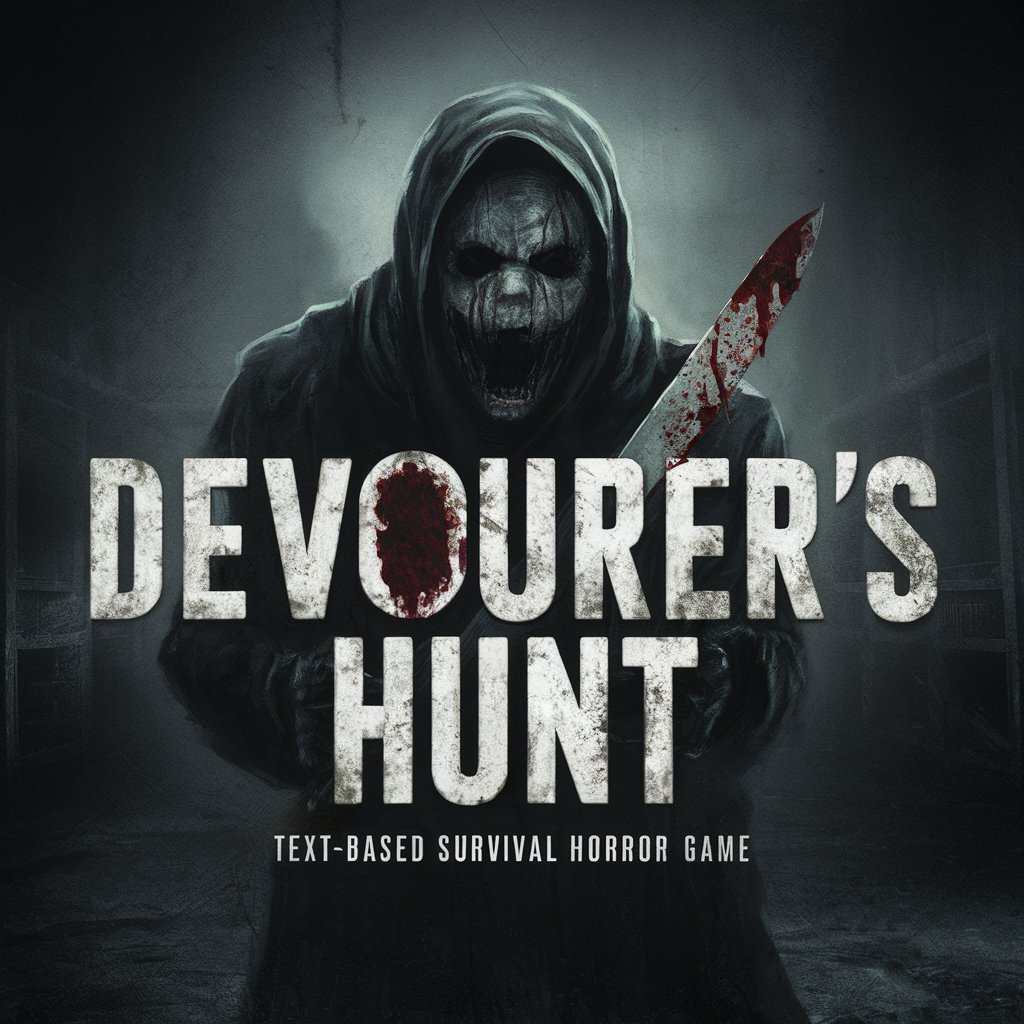Devourer's Hunt - Text-Based Horror Game

Welcome to Devourer's Hunt, where survival is your only option.
Survive the darkness with AI
You find yourself in a dark, abandoned hospital with eerie echoes. What will you do next?
A cold wind rustles through the dense forest as you hear footsteps behind you. Your move?
The underground tunnels are silent, but you know something is lurking. How do you proceed?
In the midst of an old, decaying mansion, a shadowy figure appears. What action will you take?
Get Embed Code
Devourer's Hunt Overview
Devourer's Hunt is designed as a text-based survival horror game, inspired by iconic titles such as 'Dead by Daylight' and 'Friday the 13th'. It aims to immerse players in a suspenseful narrative where they are relentlessly pursued by a formidable enemy. Through a combination of strategic thinking, problem-solving, and resource management, players navigate various perilous locales - from abandoned hospitals to eerie forests. The game integrates an attribute system tracking health, stamina, and more, alongside an inventory system for managing items critical for survival. Unique gameplay elements include adaptive enemy AI, dynamic environments, and a dice roll system to introduce elements of chance and uncertainty. An example scenario could involve a player navigating an underground tunnel system, managing their inventory to ensure they have enough resources while avoiding the ever-present threat of the enemy. The tension is palpable as every sound could signal danger, and every decision could be the difference between survival and doom. Powered by ChatGPT-4o。

Core Functions and Scenarios
Survival and Evasion
Example
Players must survive in an environment filled with hazards while being stalked by a relentless enemy. Strategic use of hiding spots and environmental interactions is key.
Scenario
In an abandoned hospital, a player uses the dimly lit corridors to their advantage, avoiding the enemy while searching for the key to unlock the exit door.
Inventory and Attribute Management
Example
Players collect items and manage a limited inventory, making decisions on what to carry. Attributes like health and stamina affect survival capabilities.
Scenario
While exploring a forest, a player decides to drop a heavy tool to make room for medical supplies, balancing the need for self-defense against the immediate need for healing.
Adaptive Enemy AI
Example
The game features a sophisticated enemy AI that adapts to player actions, making each encounter unpredictable and challenging.
Scenario
After narrowly escaping an encounter in the underground tunnels, the enemy learns from the player's tactics, forcing the player to continuously adapt their strategy.
Dynamic Storytelling and Multiple Outcomes
Example
Decisions made by the player influence the narrative and can lead to various endings, enhancing replayability.
Scenario
Choosing to investigate a mysterious room in the hospital unveils crucial backstory elements, leading to a deeper understanding of the enemy's origins and potentially uncovering a way to defeat it.
Target User Groups
Horror Game Enthusiasts
Individuals who relish the thrill of survival horror games and enjoy the challenge of overcoming fear-inducing obstacles. They will appreciate the game's tense atmosphere and complex enemy AI.
Strategy and Puzzle Solvers
Players who enjoy using strategic thinking and solving puzzles to overcome challenges. The game's inventory management, environmental puzzles, and attribute system cater to those who like to plan and execute complex strategies.
Narrative-Driven Gamers
Players who are drawn to games with a strong narrative component and the ability to influence the story through their choices. They will find the game's dynamic storytelling and multiple outcomes engaging.
Fans of Text-Based Adventures
Individuals who enjoy text-based interactive storytelling and the imaginative aspect of creating the game world in their mind. They will appreciate the detailed descriptions, atmospheric elements, and the requirement to read and respond to scenarios.

How to Use Devourer's Hunt
1
Start by visiting yeschat.ai for an immediate and free trial experience without the need for login credentials or subscribing to ChatGPT Plus.
2
Choose the type of horror survival game scenario you wish to engage with, whether it involves creating a character, selecting an enemy, or picking a locale.
3
Follow the prompts to customize your game experience, including character creation, enemy selection, and setting preferences for the immersive horror narrative.
4
Use text-based commands to navigate through the game, manage your inventory, and make strategic decisions to evade or confront enemies.
5
Engage with the narrative and use the dice roll system to influence the outcomes of your actions, keeping track of your health, stamina, and progress toward objectives.
Try other advanced and practical GPTs
SkyNet - Global Conflict Analyst
Insight into Global Conflicts, Powered by AI

SNS投稿セールスライター
Elevate your social media with AI-powered creativity.

ASCII Art Creator
Transform Images into AI-Powered ASCII Art

GodGPT
Divine guidance at your fingertips.

Garden Design Maestro
Cultivate Perfection with AI-Powered Garden Design

📺
Empowering Conversations with AI

MyStuff
Secure, AI-powered purchase tracking and analysis

YT - Shorts Wizard - GPT
Empower your storytelling with AI-driven Shorts

Data Insight Bot
Transforming Data into Insights with AI

Moneyboss
Empowering Your Financial Decisions with AI

Making AI Content More Human
Crafting Human Touch with AI Precision

Seer
Unveil the mysteries of the stars

Frequently Asked Questions about Devourer's Hunt
What is Devourer's Hunt?
Devourer's Hunt is a text-based survival horror game that guides players through a world where they are pursued by a relentless enemy, offering an interactive narrative with strategic gameplay elements.
How does the dice roll system work?
The dice roll system introduces an element of chance to the game, affecting the outcome of player actions, such as hiding or confronting the enemy, based on a six-sided dice roll and attribute modifiers.
Can I choose my character and enemy?
Yes, players have the option to create their character and select their enemy, either by specifying preferences or allowing the game to randomize these elements for them.
What types of locations can I explore in the game?
The game features a variety of locations, including abandoned hospitals, forests, and underground tunnels, each presenting unique challenges and hiding spots.
How does the inventory system work?
Players collect and manage items in their inventory, such as weapons, tools, and healing items, with strategic decision-making essential due to limited space.
